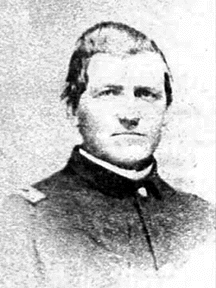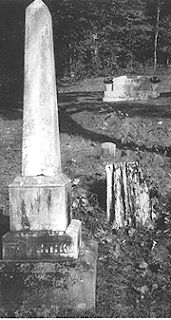
Wiley C. Patrick, son of Meredith and Rebecca Williams Patrick, was born on December 9, 1835 in Magoffin County, KY. In 1861, when the Civil War broke out, Wiley decided to cast his lot with the Union. He left his wife Polly Huff Patrick and three small children and made his way to Louisa in Lawrence Co.,KY, were the 14th KY Infantry Regiment was forming at Camp Wallace. He filled an original vaccancy as 1st Lieutenant in Co. I, 14th KY Infantry [US] and joined the regiment for duty on November 10 and was mustered in at Camp Wallace on December 10, 1861. On May 5th, 1863 he was promoted to Captain of Company I. His brother Elijah later served in the same company, as did a great number of other Magoffin County boys.
In April 1864, the 14th KY received orders to join Sherman's Atlanta Campaign. On May 23, the regiment arrived at Cass Station, GA and within days proceeded to join the 23. Army Corps, also known as Army of the Ohio, at the front near Burnt Hickory. Continuous fighting and skirmishing became the order of the day while Sherman's Army slowly wound its way through Georgia. Hastily dug trenches and thrown up breastworks barely protected the men from Confederate sharpshooters who made it quite dangerous for the men to move about freely even if it was only to get a drink of water from a nearby creek.
On June 2, 1864, the 14th KY participated in an engagement that would result in the regiment's first heavy casualties during this campaign. Among them would be Captain Wiley C. Patrick. The following is an account of events that ultimately, on this fateful day, led to his untimely death at the age of 28.
During the previous night, General Schofield, commander of the 23. Army Corps, received orders from General Sherman to turn the Confederate right, "so as to get on the waters of Alatoona Creek", about 2 miles northeast of Pickett's Mill. Rain began falling early in the morning and after all the necessary preparations were completed, Schofield's troops began moving at 8 a.m. in rear of left on the Alatoona road to the extreme left of Sherman's Army until they reached the Burnt Hickory and Marietta road, near Cross Roads Church (also known as Burnt Church), and then turned east.
The 14th KY formed the extreme left of the front line of Strickland's Third Brigade (Hascall's Division), two lines deep. This was a very dangerous position as it left the regiment exposed on the flank. Progress was slow and frequent halts were necessary because of the almost impenetrable loblolly pine forest which was so dense that the men were unable "to see two rods" or see those on their right or left. Only with great difficulty did the skirmish line move in accord with the line of battle, which was directed by compass. The brush was so thick and interlaced that neither man or horse could force a way through it. The soldiers had to march around the brush, re-connect and rectify the direction and resume their advance once more.
Once the troops left Alatoona road, their advance was sharply contested by dismounted Confederate cavalry all through the woods. Around 10 a.m., after passing over the divide separating Pumpkin Vine Creek and its branches from Alatoona Creek, the 14th KY reached open ground near the creek's west side - a little swampy valley - and went into position. The Confederate batteries, situated at an entrenched line on the east side of Alatoona Creek, obtained good range of the Union troops and began throwing a galling fire in every direction, sweeping the valley at intervals and making it unpleasantly hot for the massing lines who were finally ordered to lie down. Stretcher bearers were continuously filing by with their ghastly loads.
At 11 a.m., the 14th KY was ordered to be ready to charge the Confederate line which was anxiously received by the men of the regiment. Almost simultaneously, heavy clouds had gathered and "Heaven's Artillery opened in grand style". The rain increased in intensity and was pouring from the dark and gloomy sky above, making it difficult for the men to load their guns. The lightning flashed and cut in zigzag streaks, and for a time the roar of the thunder and the enemy's cannon mingled so that it was hard to tell one from the other. While lying on the muddy ground, the men were soaked to their skin in a short time. Finally, after what appeared to be an eternity, the actual order came down the line to move forward and charge the enemy's works and the men started "hooping and holowing and shooten". The 14th KY attacked with vigor and with a sharp fight turned the enemy's flank, driving them back about two miles across Alatoona Creek, which was muddy and swollen by the rain to the depth of three feet. Hascall's division pressed on and began to develop the line of the enemy's works at James Foster's house, near the junction of Burnt Hickory and Marietta roads with the Dallas and Acworth road. The 14th KY's left rested within 150 yards of the enemy's fortifications, from which the Confederates fired grape, canister, solid shot and shell. Company A, under command of Captain James C. Whitten, formed the skirmish line in the immediate front and advanced to within 50 yards of the masked enemy's battery.
In the charge upon the enemy's works, Captain Wiley C. Patrick was killed while leading Company I. Finding the enemy's works too strong, the men layed down under a shower of grape shot. Six or eight shells burst among members of Captain Patrick's company, wounding several. A shell also seriously injured Captain Whitten in his right hip, disabling him for the duration of his service. The bullets, as one member of the 14th KY described it," was a flying as putner as fast as I ever saw it hale.." Eventually, a lodgment was made by the 14th KY at Foster's house, despite stubborn resistance by the Confederates.
Around 4 p.m., the storm finally had passed and as night began to fall, the sun "unexpectedly shone out for a few moments as it retired behind the hills in a blood-red sheen of glory, leaving a few moments later a darkened earth behind, made doubly gloomy by the brightness of the disappearing luminary". A further advance was found to be impracticable and after a hard day the men of the 14th KY hastily began to entrench their line and barricaded for the night.
For Captain Wiley C. Patrick, the fighting was over. In their subsequent reports, Colonel G. W. Gallup, commander of the 14th KY, called Patrick "noble and gallant", while Colonel Silas Strickland, commanding brigade officer, found him to be "a most brave and gallant officer." His body was buried by his comrades near the battlesite where it remained until 1866, when his brother Elijah Patrick made the trip back to Georgia to recover the remains. Arriving at Atlanta, Elijah Patrick hired an oxen team and with several men, proceeded to Captain Patrick's burial site and removed the body. It was placed into a pine box, which was taken back by train to Catlettsburg, KY and then transported to Magoffin County by wagon.

Wiley C. Patrick's body was re-intered in the Meredith Patrick Cemetery. A white stone monument marks the grave. One of the inscription reads: Capt. Wiley C. Patrick of Co. I, 14 Reg. Kentucky Vol. Infantry, Born Dec. 9, 1835, Fell in Action June 2, 1864. During Captain Patrick's burial, a Georgia pine seed that had accidentially clung to the body, was lowered into the grave as well. Over the years, it grew into a tall strong tree until it finally had to be cut down. A tree stump is all that remains today - a silent reminder of the tragic death of one of Magoffin County's finest.

On Memorial Day weekend 2001, Captain Wiley C. Patrick was honored with a special ceremony by the 14th KY Heritage Society, the Magoffin County Historical Society and the KY Department SUVCW.

A new Georgia pine seedling, specially obtained by a 14th KY descendant from near the battlefield where Captain Patrick fell, was planted at his gravesite. Several family members were in attendance for the ceremony.
Photo of Captain Wiley C. Patrick courtesy Bob Kinner.
Photos of Memorial Service courtesy of Connie Wireman.




